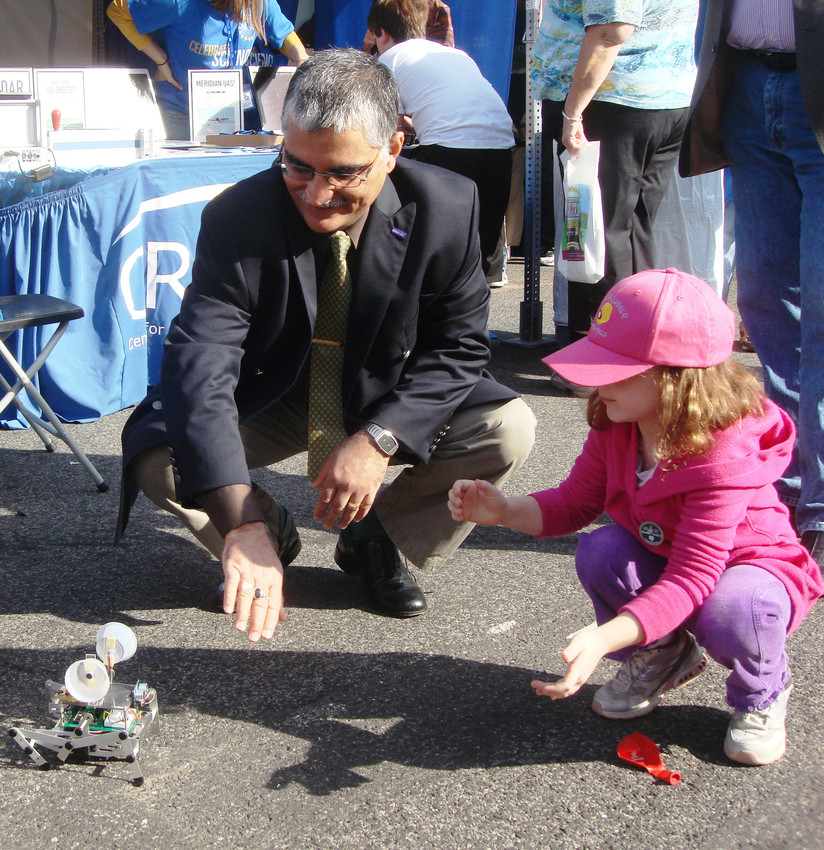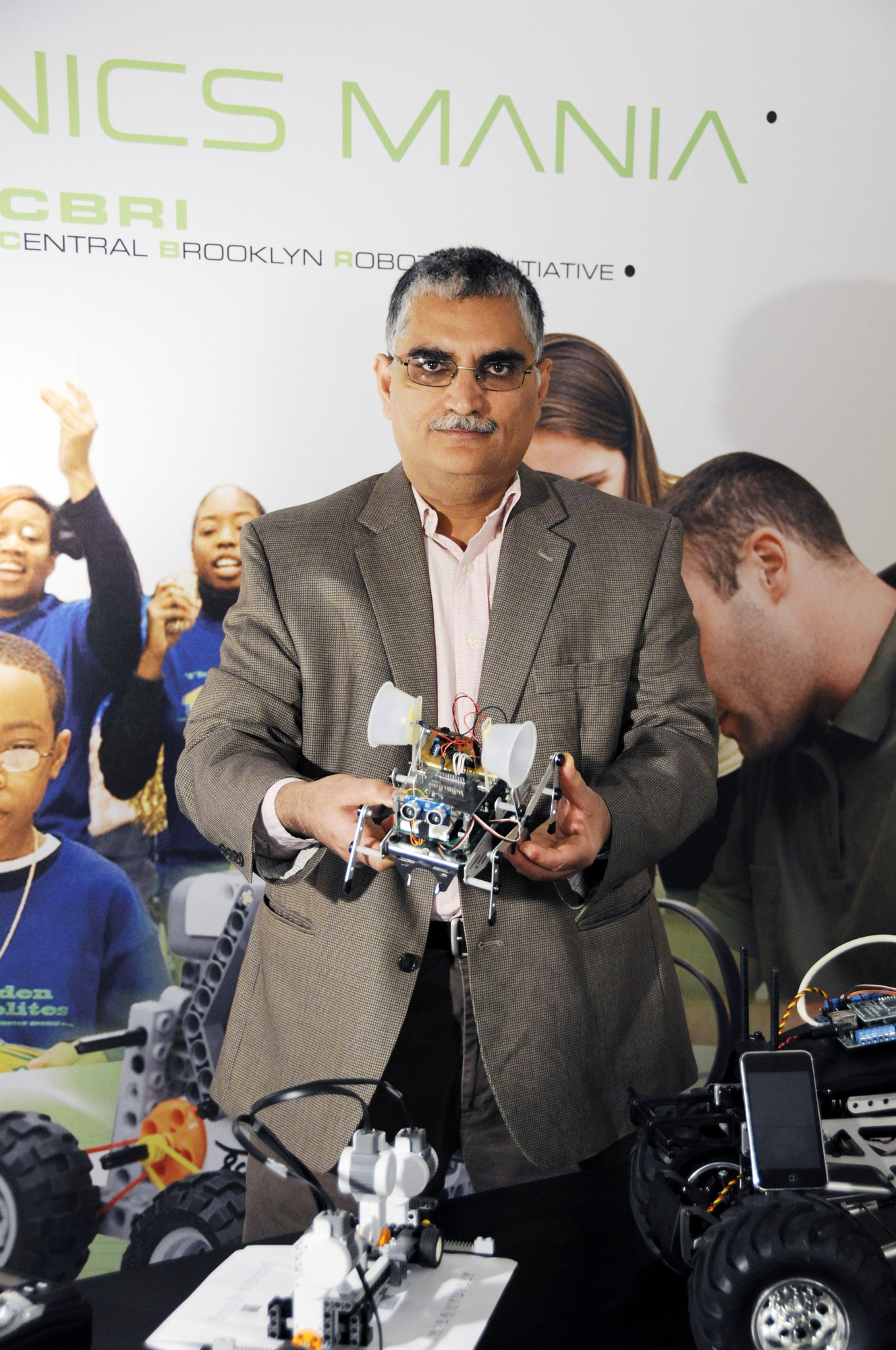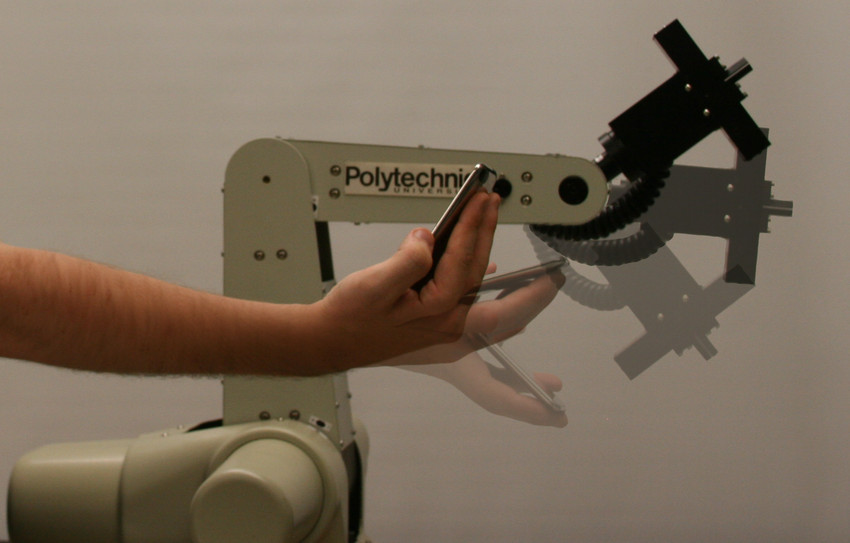Controlling Robots with Cell Phone Applications

This ScienceLives article was provided to LiveScience in partnership with the National Science Foundation.
If robots are to become as common as household pets, everyday people will need to control and monitor them easily. That's one of the purposes behind two apps that Polytechnic Institute of New York University's (NYU-Poly) Vikram Kapila created, which turn the iPod touch and the iPhone into remote controls for robots. Using the iLabArm app, a user can pinch the screen of an iPod touch to make the finger-like grippers of an arm-like robotic manipulator open and close, along with other movements. The iLabBot app makes it as easy as taping directional buttons on an iPhone screen, or tilting the device to control a mobile robot. Kapila and his students designed the apps' graphical user interfaces to be intuitive and easy to use, but that doesn't limit their usefulness to fun and games. The professor of mechanical engineering sees their potential in medicine, manufacturing, laboratory research and the military. They could also provide special-needs children with entertainment, learning and peer-engagement opportunities.
This is the latest mechatronics project included in the Kapila-directed NYU-Poly Research Experience for Teachers program, funded by the National Science Foundation (NSF). The program provides paid research and training opportunities for K-12 teachers that enhance their STEM (science, technology, engineering and mathematics) skills.
Kapila holds a Bachelor of Technology degree from Regional Engineering College, Calicut, India (1988), a Master of Science degree from Florida Institute of Technology (1993) and a Doctor of Philosophy degree from Georgia Tech (1996). He joined NYU-Poly in 1996.
Name: Vikram Kapila Age: 45 Institution: Polytechnic Institute of New York University Field of Study: Mechatronics
What inspired you to choose this field of study? The field of mechatronics – the synergistic integration of mechanical engineering, control theory, computer science and electronics to manage complexity, uncertainty and communication in engineered systems – offers me rich opportunities to make theoretical, computational and experimental advances. I'm especially interested and inspired by the opportunities it gives me for educational innovation from K-12 schools to undergraduate and graduate programs at the college level.
What is the best piece of advice you ever received? There is no shortcut to success except hard work. Seek research directions that appeal to you, and patiently keep working along.
Get the world’s most fascinating discoveries delivered straight to your inbox.
What was your first scientific experiment as a child? I prepared a demonstration to produce carbon dioxide by mixing marble and hydrochloric acid.
What is your favorite thing about being a researcher? As a faculty researcher, I get to train and work with the next generation of scientists and engineers. We get to explore new theoretical and experimental research directions and create new bodies of knowledge. I find immense satisfaction when my graduate students explore and develop new research directions and teach me new concepts. In addition to sharing our results with the research community, I enjoy being able to broadly disseminate our findings to K-12 teachers, students and the general public.
What is the most important characteristic a researcher must demonstrate in order to be an effective researcher Perseverance. Research is not a nine to five, five-days-a-week job. When you are engaged in a new research topic, your whole being is completely engrossed in your quest for a solution to the research problem of the moment. When you are in such a state, often a breakthrough will arrive not when you are sitting and working on your desk or lab, but when you are doing seemingly unrelated things and your mind is still working on the research problem. So once you identify a problem of interest, give it your best even if it takes longer than you expected.
What are the societal benefits of your research?
Our apps for robot control provide intuitive and natural interfaces for human-robot interaction. This can allow non-experts to effortlessly interact with robots. Such a human-robot interaction framework can impact advances in medicine, manufacturing and the military. Moreover, robotics, iPod touches and iPads offer a powerful combination to impact STEM learning in K-12 environments. Finally, we expect this work to benefit special needs children by providing them with entertainment, learning and peer-engagement opportunities.
Who has had the most influence on your thinking as a researcher? Wassim M. Haddad, a professor of aerospace engineering at the Georgia Institute of Technology, has tremendously influenced my thinking as a researcher. He was my graduate mentor during my M.S. and Ph.D. studies. The foundational theoretical training that I received under his supervision held me in good stead even as I explored and developed an experimental research, education and mentoring program.
What about your field or being a researcher do you think would surprise people the most? People may be surprised to find out that my research team and I actually love doing what we do in our research and lab. Once they see all the cool mechatronics devices, robots and iPhone-based interfaces for human-robot interaction, they understand our passion for this research.
If you could only rescue one thing from your burning office or lab, what would it be? It is not even funny that you ask me this, since I actually lost my office to an electrical fire in November 2007. The day after the fire when I arrived, most of the documents and books were damaged either by fire or by fire retardant. My desktop computer had stopped working. However, I was able to get a company to recover all of my data from the hard drive. I hope I do not have to suffer through another office or lab fire, but if I have to save one thing from a burning office, it would be the file of my hand written notes from my desk. At this time, I have scanned a lot of my notes and I have multiple backups of my work at different locations to be fully prepared!
What music do you play most often in your lab or car? I don't listen to music in the lab or office, and I mostly listen to NPR in car. My wife recently gave me my very own iPod mini, and now during my mass transit commutes I sometimes listen to meditation music or old Bollywood (Hindi) music.
Editor's Note: The researchers depicted in ScienceLives articles have been supported by the National Science Foundation (NSF), the federal agency charged with funding basic research and education across all fields of science and engineering. Any opinions, findings, and conclusions or recommendations expressed in this material are those of the author and do not necessarily reflect the views of the National Science Foundation. See the ScienceLives archive.





